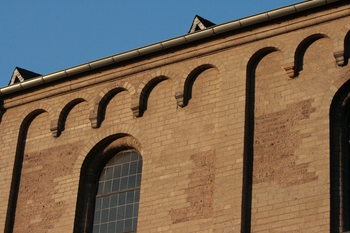Lombard band
The frieze (usually arched frieze; rare pointed arch frieze ) is an ornament in architecture and is considered one of the oldest forms of the frieze. It consists of rows of semi-circular arches, the legs can rest on small consoles. This frieze strips served mostly as the top component ( a portion ) of the outer wall or to stimulate and structure the facade and was regularly combined with pilasters.
History and distribution
Forerunner of the arched friezes found in Byzantine architecture ( for example in the series of blind arches on the Mausoleum of Galla Placidia in Ravenna, northern Italy ) in the lived on the ancient Roman architecture.
These suggestions intervened on the resident has become in the wake of the Great Migration in Italy Lombards. Arched friezes are one of the character defining features of the Lombard style of architecture, what the English or French names ( lombard tape or bande lombarde ) illustrate today.
From northern Italy, the use of the bow Friese has spread to Western and Central Europe, particularly in the Romanesque and Gothic architecture - possibly stimulated by pilgrims who had come to appreciate on their trips to Rome this form of architecture in northern Italy. Play an essential role arched friezes also in Romanesque architecture in Catalonia, where they found 1011 spread after a trip to Italy the abbot Oliba in years.
Tower of the Abbey of Pomposa, northern Italy ( 1060 )
Tower of the Cathedral of Uzes, Provence ( 1100 )
Tower and apse of Sant Climent de Taüll, Catalonia ( 1120 )









